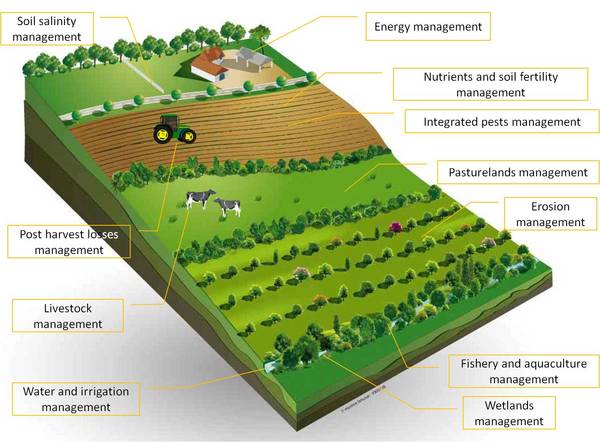Agriculture, Sustainable
High-Level Conceptualizations: Some Foundation Principles
Since the 1960s the concept of sustainable agriculture has been increasingly used to denote a variable but significant rupture with what has been termed the more dominant agri industrial model of agriculture and rural development. In general terms it can be defined as referring to the environmental or ecological soundness of the agricultural production processes or the wider agrifood commodity chain. This implies that with respect to renewable nutrient cycles, such sustainable systems are those that are capable of being continued indefinitely, or at least over considerable generational time. In many zones we might argue that agricultural systems have long been sustainable (since Neolithic times), in that while they may have been subject to considerable adaptation and technical changes, they have sustained in reasonable shape the main factors of production needed for the continuance of food production both 'in' and 'of ' place. In addition, they have managed to do this without significantly destroying the local and production based ecologies on which they are based.

It has also long been established that agriculture, as a production process, is quite distinctive in that it both produces and transforms nature, through the (re) production of livestock and plants, at the same time as being physically and geographically reliant upon nature as a 'means' and 'condition' of production (most notably soils, micro climate, topography, and vegetation complexes). Agriculture, and especially a sustainable agriculture, thus efficiently transforms, as well as recreates its space or terroir as part and parcel of the production process. Usually the indefiniteness of sustainable agriculture makes primary reference to a set of ecological principles, and it is also linked to not so much an endpoint, sui generis, but rather as a continual and increasing 'contested process'. In this sense it needs to be recognized that there will always be ways in which agro food systems can be adapted, which make them more (or less) ecologically, economically, and socially sustainable. In general and abstract terms then the 'process' of sustainable agriculture must infer a 'coordinated relationship between humans, organisms, and environment, which is adaptive to location, season, creating biophysiologically or ecologically mutual benefits which give complementary status to the different components of the production system'.
Such explicit complementarities were a central part, for instance, of ancient Chinese classical works written about 3000 years ago. Here agriculture needed to be practiced as part of the harmony between heaven, Earth, and humans; and between the careful utilization of the five key elements of the universe: that is, metal, wood, water, fire, and earth. These principles and adaptive techniques were passed down under systems of 'inherited experience'. For instance, in the Tai Lake basin area of Southeast China, the grain–livestock–mulberry–fish integrated production system has existed for more than 1000 years, by means of a cycling based on ecological food chains and synergies between the different but complimentary production systems.
In many cases both now and in the past, therefore, we see examples of long standing agricultural sustainability. This has, however, increasingly been associated with those areas (often regarded under the twentieth century agriindustrial modernization project) as being geographically marginal to the mainstream, lying beyond the productivist industrialization of agriculture. Sustainable agriculture is commonly associated in this general and abstract sense as being ecologically self sustaining with low inputs, economically viable, of a sufficient scale and diversity which limits long term changes to the environment, and is eth ically and aesthetically acceptable. More recent writers often tend to define it in oppositional terms with the agriindustrial model of development, involving a rejection of high external input systems and encouraging greater in volvement of local farmers, protecting their unique knowl edge systems, and in incorporating their active resource conservation techniques within a production framework.
These oppositional definitions have grown since the 1970s, as the environmental, social, and economic problems associated with the agri industrial model have come to the fore. Of particular importance here is the ability of the sustainable agricultural systems to maintain levels of productivity in the face of periodic shocks or stress. Rather than using external inputs, like fertilizers and pesticides, that usually have to be purchased at prices outside of the control of the farmer, internal resources on the farm or in the community, such as natural parasites and predators of pest, algae, bacteria, and green manure providing nitrogen, agroforestry and cropping systems reducing erosion, underexploited wild tree and fish species, and indigenous crop varieties with tolerance to salts and toxins, provide the potential for being both renewable and ecologically more efficient.
As these principles have reemerged, differing stances on agricultural sustainability have developed between, for instance, farmer groups (stressing especially the sustainability of the farm business and family farming), and a widening array of environmental interests who stress 'deeper' ecological principles associated with reducing waste and enhancing systematic recycling and renewable practices. These divisions in thinking have led to different expressions of sustainable farming practice from organic certified farming, through to community supported agricultures, short food supply chains, and the rapid development over the past decade of different types of farmer driven 'farmers markets'.
Widening and Grounding Key Principles and Concepts
Agroecology and Ecological Modernization Perspectives
The Sustainable Rural Development Paradigm in Europe
Some Conceptual Building Blocks for the Sustainable Rural Development Paradigm
Conclusions: Prospects and Challenges for Sustainable Agricultural and Rural Development